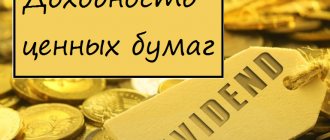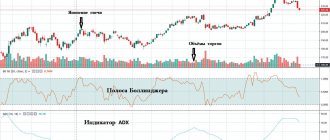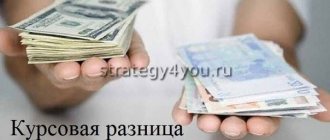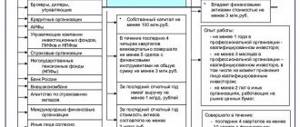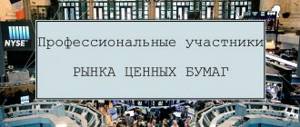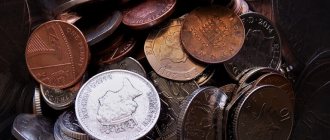09/15/2015 10,658 6 Reading time: 7 min. Rating:
Author
: Konstantin Bely
Investment risk and profitability : these two quantities are always inextricably linked and depend on each other. I have already spoken about this many times, but today I decided to write a separate article to consider this connection in more detail and even clearly. The ratio of risk and return is, perhaps, the main value that any person who wants to invest money somewhere should pay attention to. Even in a bank, not to mention more complex and risky investments. So let's start with definitions.
Stock exchange concept
The stock market is a mechanism that ensures the movement of monetary resources from one sector of the economy to another. The commodity is securities, which is why you can often hear the concept of “securities market”.
Securities include:
- stock;
- bonds;
- bills;
- checks;
- mutual funds;
- futures;
- options.
The purchase and sale of these securities is carried out on a special trading platform - the stock exchange.
The work of the exchange is supported by professional intermediaries between the buyer and the seller: brokers, banking institutions and investment firms. Thanks to them, private investors can freely access the stock market.
ATTENTION!
The relationships between participants and work processes on the exchange are regulated in accordance with the Federal Law “On the Securities Market”.
It is also possible to purchase some types of securities outside the exchange. However, this trading option comes with certain nuances:
- Availability of intermediaries. If you exclude the exchange from participating in the process, you still cannot do without the services of intermediaries, since transactions in the over-the-counter market do not take place through the purchase and sale of securities “from hand to hand.”
- Risks not protected by the exchange. In this situation, the transaction process is not controlled by the exchange, that is, you are not protected from charlatans.
Most people consider the stock exchange to be a noisy place where employees with many telephone receivers in their hands shout out bets, but nevertheless this period has passed. Today, exchange activities have switched to electronic mode.
Main exchanges in the Russian Federation:
- "Moscow Exchange". In addition to the purchase and sale of assets, trading in foreign currencies, products and derivative financial instruments takes place here.
- "St. Petersburg International Commodity and Raw Materials Exchange". On this site, trading takes place in raw materials, as well as special derivative assets, which make it possible to conclude the most profitable agreements for this product - futures.
What does risk-free investment mean?
Investments, like finance in general, do not exist in an ideal environment. Sudden political events, defaults of individual economies and natural disasters are almost impossible to predict, so this type of risk always exists. But it is not specific to investing, so it can be ignored, simply keeping it in mind as a force majeure.
Risks can only be understood as the probability of losing the initial capital or part of it, or it can be understood as the probability of not making a profit while maintaining the safety of the invested amount. Depending on this, the list of financial instruments suitable for an investor may differ.
Risk-free investments are characterized by:
- guaranteed profit, usually at a fixed level;
- high liquidity of the asset or assets underlying the investment;
- low or average profitability.
There is a concept in finance - the risk-free interest rate. This is the level of profit that can be achieved through a financial instrument with zero risk or through an asset with the highest degree of reliability (the risk of bankruptcy of such an asset is minimal). The risk-free rate can be considered as a reference point by most private investors, keeping in mind that if an investment portfolio offers a return below the risk-free rate, then such a portfolio is ineffective. There are several ways to calculate the risk-free rate, but for national currencies they usually use calculations based on the key rate, the yield on deposits, or the yield on securities issued by the government. At the time of publication of this material, the key rate of the Central Bank of the Russian Federation is 7.5% per annum. Next to this value are the average rates on deposits in reliable banks and the yield on government ruble bonds. Are there investment products that can yield more without increasing your risk? Yes, but with reservations and some restrictions.
Key features of the stock market
Among the advantages of the stock market, the main ones can be identified:
- stable income in the form of dividend payments from investing in shares;
- development of promising projects, attracting third-party investments;
- income from trading (purchase and sale of securities when quotes change);
- providing personal funds for trust management to professional brokers and traders;
- additional issue of securities, allowing developed commercial projects to move to a new stage of development and profitability.
Relationship between profitability and investment risk
The higher the profitability, the better, it seems obvious. This rule would work well among risk-free assets, but they simply do not exist. There is always a possibility of losing some or all of your investment - that is the nature of the investment.
Higher returns are much more often achieved due to an additional increase in risks than due to the higher quality of the instrument itself. I found a strong relationship between the risk indicator MSD (standard deviation) and return for the year:
The X axis is the annual return, the Y axis is the standard deviation. The trend line shows that the higher the annual return, the higher the risks of the PAMM account in the form of the standard deviation indicator.
This relationship, in simple words, is a correlation, and quite a strong one. In a study of 3000 PAMM accounts, I calculated the correlation between the standard deviation indicator and profitability and received a value of 0.44, which means a strong dependence on such a large sample. In other words, the relationship between profitability and risk is confirmed mathematically.
The investor’s task is to find his own balance between profitability and risk, to more accurately determine his propensity for risky investments. For web investments, the minimum acceptable return is at the bank level, multiplied by two (a large bank itself is more reliable than a Forex broker). Then it depends on the investor - to concentrate on minimizing risks and receive x2-x3 from bank profitability or try to take on additional risks to earn more.
All the above formulas allow you to calculate the final return on investment - we invested, time passed, and we received money. If we talk about such investment tools as PAMM accounts, trading robots, copying trades - this is not enough, there are trading risks and many other pitfalls that can lead to unnecessary losses.
The investor must know what will happen to his money in the process, for this reason these instruments are always accompanied by profitability charts.
Three main niches in the stock market
The stock market consists of three main segments:
- Starter market. In this section, start-up firms sell their own shares through listing operators. Large amounts of money are often invested here in search of promising startups. The leading participants are large investment lenders and hedge funds, analyzing future projects in detail.
- Trade market. Here, active purchases and sales of issued shares are carried out, which are sold according to the current exchange rate. Organizations issuing shares no longer take part in these agreements.
- Over-the-counter stock market. The work of this sector is supported by two players - a broker and a trader, who enter into mutual agreements via remote or telephone modes. Online trading platforms are often used for these CFD transactions.
ATTENTION!
Nowadays, online trading is considered a popular profession by several thousand Internet users.
Classification
There are two main types of stock market:
- Primary. Involves trading in newly issued securities—the buyer purchases the asset directly from the issuer.
- Secondary. Involves trading in securities previously issued and purchased on the primary market—purchase from an intermediary.
Stock markets have varieties according to some other criteria:
- by issuers - the government securities market and the securities market of private organizations;
- by type of asset - the market for shares, bonds, futures and other derivatives;
- by territory - international, national and regional;
- by period - the market for short-term, medium-term, long-term and perpetual securities;
- by exchange basis - exchange and over-the-counter;
- by areas and other characteristics.
How to regulate the risk and return of a portfolio?
An investor should develop his own method of selecting the highest quality ones in the investment captivity of the Central Bank in order to not only preserve, but also increase his finances. The ability to evaluate assets according to this principle will allow you to form an optimal investment portfolio and earn decent money without going broke.
Currently reading: The concept of financial transactions and their types
Let us highlight the main activities that allow us to achieve the main goal of portfolio formation - to obtain the current level of expected profitability at the lowest possible level of predicted risk:
- Portfolio diversification. Investor funds must be distributed so that the portfolio contains financial assets with different levels of risk. It is worth investing not only in securities issued by private domestic companies and the government of the country, but also by transnational corporations. It is worth selecting instruments of different types: stocks, bonds, options, precious metals, futures, etc.
- Careful selection of financial instruments based on stock market analysis not only in the short term, but also in the long term. If your own knowledge in the field of investing is not enough, you can turn to large investment funds for help.
None of the existing methods of reducing investment risks can reduce them to zero. One way or another, the investor will risk the invested funds, but the price of such risk can be different and is determined by the return on assets.
Artem Petrov, financial analyst
Functions
The purpose of the stock market is as similar as other types of markets - to help buyers and sellers find each other.
Let's consider additional, but no less important functions of the stock market:
- Concentration of available funds. After the meeting of the stakeholders, the need for this important function arises as the stock market provides investors with a wide range of options to invest the funds accumulating in the market.
- Distribution of funds. Concentrated savings are distributed into various economic sectors, moved from one organization to another, and also make it possible to eliminate the state budget deficit through the issuance of government bonds.
- Attracting foreign capital. If an interesting and promising enterprise becomes a participant in the Russian market, it will be able to attract financial resources from a foreign investor for its own development in order to use it on the domestic market. Such an investment will benefit not only the company itself, but also the residents of the Russian Federation, for whom new jobs will appear.
Participants
Participants in the stock market are:
- Issuers are producers of securities.
- Investors are buyers of securities.
- Professional intermediaries are individuals and firms for whom trading in the stock market is their job (brokers, dealers and traders).
Everything with manufacturers and buyers is quite easy and understandable, but the activities of professional participants are worth a little explanation.
They are intermediaries because they buy assets not as property, but for personal clients.
The essence of their activity is to increase the money invested by the client by conducting special transactions on the stock market.
ATTENTION!
The work of intermediaries can be called speculation, in which they buy goods cheaper and sell them more expensive.
For their mediation, participants receive a percentage of the income received as a result of trading. To be able to operate on the stock exchange, a person must confirm his own skills and have a special license issued by the Central Bank of Russia. The government agency is strict in issuing licenses and closely monitors any violations that serve as grounds for revocation of a license.
Taking into account such requirements, we can conclude that it is not easy for fraudsters to get into the stock market, and each active participant values his own license.
ATTENTION!
If you were afraid to invest money using the stock market because of doubts about the reliability of its participants, you can rest assured, since this is a completely civilized and controlled market.
The myth about the lack of “kitchen” in futures and options
Clients are convinced that, unlike the Forex market, among brokers there are no so-called “kitchens” that organize trading within the company, and the exchange protects the asset from any manipulation, because it is accountable to government regulators. Therefore, trends are amenable to logical fundamental and technical forecasts, driven by logical supply and demand.
This is indeed true - a broker cannot organize the “kitchen” on his own, which cannot be said about the exchange itself. National trading platforms try to offer traders a large list of trading instruments, using data from international trading centers, including the Forex market, for course education.
Few people pay attention to the fact that according to the Agreement, the exchange must, but is not obligated to keep these rates in compliance. What does this mean in practice? In particular, on the Moscow Exchange, a trader may well, when trading oil, metal or currency futures, receive an unexpected jump in the rate by several percent, different from global values.
In Forex practice, this phenomenon is called a spike, and a decent broker will return funds to the injured client in 99% of cases. In the case of the Moscow Exchange, this is called a “market”, and no one will return the losses from the difference.
A recent illustration of this behavior was the trading of Brent oil on December 25, 2021. The platform, taking advantage of the fact of closed trading on US exchanges, sharply lowered the oil price by 11% during a 40-minute trading break. Thanks to the “bar” mechanism described in the article above, many positions were closed by margin calls or stop outs.
This is not the first case of such a price difference; previously, the rates for EURUSD futures, palladium and gold contracts “ran away” in relation to world prices. All of the above stories were investigated by the Central Bank of Russia, which did not notice any violations or facts of price manipulation.
Types of shares
A share is the most popular security that confirms the holder’s right to a share of the property of the corresponding organization with the payment of dividends from income.
Non-preferred and preferred shares
There are two main categories of shares:
- Unprivileged. These shares entitle the holder to participate in shareholder meetings and receive dividends as part of normal distributions. These securities are the main objects of purchase and sale of the stock market.
- Privileged. They allow you to receive dividend payments and give priority to the company’s property during its liquidation. Such assets are more often distributed between the founders of the organization and their close people.
ATTENTION!
These securities grow in value less quickly than cryptocurrency, but they are characterized by good reliability and timely payment of dividends.
Earnings on shares
In the modern world, the stock market uses a number of basic strategies that allow you to make money on the purchase and sale of securities, even with small initial investments:
- search for undervalued assets with investment in the predicted price increase;
- concluding contracts taking into account the P/E (price/earnings) indicator, reflecting the amount in US currency that a trader must spend to receive $1 of net profit;
- identifying the general market trend using the “swing trading” scheme, which consists in calculating the general prospects for market transactions to increase or decrease with the prompt execution of transactions on short positions;
- the use of CFD transactions, which are concluded for the difference in value, is the most simplified method that provides the opportunity to get started without any specific preparation.
ATTENTION!
Don't forget that every stock market agreement involves certain risks. Their minimization is the main responsibility of professional traders and brokers.
Purpose and process of issuing securities
Issuers produce securities: companies, the state or its individual entity, and even a city.
The purpose of issuing these assets is to raise funds. Before releasing assets, the issuer analyzes the volume of missing resources and determines their form.
An organization can receive money in several ways:
- by issuing bonds - debt receipts, in which investors provide the issuer with their own funds, subject to receiving a certain percentage;
- by issuing shares - securities that give the buyer the right to co-own the company.
The organization sets the parameters of assets: quantity, nominal value and period of its validity. Next, state registration of the issue is carried out by making an entry in a special register.
ATTENTION!
Securities that have passed the registration procedure are placed on the stock exchange for purchase by investors.
Market risk
Systemic and non-systemic market risk
As we already discussed in the article about asset classes and stock indices, market risk can be systemic and non-systemic:
- Unsystematic risk is the risk of individual assets (securities), also called individual issuer risk and idiosyncratic risk . If you buy an individual security, its issuer (company) could go bankrupt (credit risk), which means you could lose money.
- Systemic risk – the risk of the entire market as a whole, that is, market risk. According to research, as the number of securities in a portfolio increases, the risk of individual issuers quickly approaches systemic market risk. This number may vary for different markets and periods, but we can say that already with 30 shares, as a rule, there is an unsystematic risk
and the investor receives systemic market risk. Simply put, the credit risk of individual companies and the volatility of prices for individual securities cease to play a significant role.
Standard deviation
Random variables have an average value, which is called the mathematical expectation of the random variable. The spread of values of a random variable is called variance , and the square root of the variance is called standard deviation . Another name for it is standard deviation or standard deviation. It is denoted by the lowercase Greek letter sigma – σ.
Let's consider the calculation of all these quantities using a simple example. Let's imagine that we have a coin and we toss it 10 times. We took tails for zero, and heads for one and got the following set of random values: 0, 0, 1, 1, 1, 0, 0, 1, 0, 1 (I got it from a pseudo-random number generator, so they really are almost random).
The mathematical expectation (average value) in this case was 0.5, expected for a coin =). The dispersion of these values is 0.28 (we will omit the calculation using the formula for simplicity). And the root of the variance, that is, the standard deviation, is 0.53.
Now let's take a more practical example - the return on the Russian stock market along with dividends for the last 5 years (2014-2018): -1.84% (2014), 32.28%, 32.78%, -0.19%, 19.09% (2018).
Here the mathematical expectation was 16.42%, the variance was 2.84% and the standard deviation was 16.85%. Below we will look at how to interpret it.
The convenience of using standard deviation is that it is measured in units of the random variable itself (that is, in the case of interest rate return, in percentage, but in the case of our fictitious coin it was just a number). Thus, it is convenient to correlate one with the other. When they talk about the volatility of an asset (the variability of its prices), they usually mean its standard deviation.
The graphs show two series of values that, having the same average value (mathematical expectation), show different dispersion.
It is important to understand not only what kind of profitability an asset can bring, but also how much its price can change over time. The graphs above show how differently the same result can be achieved and how important it is to look not only at the profitability, but also at the spread of returns it is achieved.
So, the standard deviation shows how far the data values are from their average value. And to put it very simply and in relation to financial assets, the standard deviation shows how much the price of an asset jumps up and down on the chart.
Let's look at real examples of the difference between assets with low and high standard deviation (images are clickable).
The blue bars on the chart are shares of developed countries, the yellow bars are government stocks. US bonds (with duration up to 3 years).
The charts above show the capital gains and annual returns of two assets from 1977 to 2021:
- MSCI World Net Index is an index of shares of developed countries with total return (including dividends). RMSD of annual dollar returns = 17%.
- Short-term US government bonds (with duration up to 3 years) – SD of annual dollar yields = 5%.
The wider dispersion of returns in the second graph and the amplitude of equity changes in the first reflect the difference in standard deviation between assets.
The two graphs below show historical price volatility and standard deviation of returns for US stocks and bonds. Based on them, it can be noted that:
- the market risk of stocks, measured as the standard deviation of returns, was higher most of the time than that of bonds (as were their returns, as can be seen in other charts);
- The market risk of any asset is not constant and changes over time, so standard deviations measured over different time periods will differ.
Historical volatility of stocks (left) and bonds (right). Source: Morningstar, Inc.
Standard deviation of 5-year returns for certain US asset classes: small cap stocks, large cap stocks, long-term government bonds, treasury bills. Source: Morningstar, Inc.
Interpretation of standard deviation
What does knowing the standard deviation of a particular asset give us? With its help, we can easily estimate the risk of a particular investment using the three sigma rule .
Normal distribution curve. The X axis is standard deviation, the Y axis is probability. Percentages are the frequency of the standard deviation value falling within the shaded area under the curve. Source: Wikipedia
The thing is that almost all values of a random variable with a normal distribution (in the stock market the distribution of returns is not normal, but over long intervals it is close to it) are contained in the interval ± 3 standard deviations, that is, the probability that the random variable will take a value greater or less than its mathematical expectation ± 3 deviations, is minimal (less than 0.3%).
- Probability of an event occurring within the interval ±1 sigma = 68.3%;
- ±2 sigma = 95.5%;
- ±3 sigma = 99.7%, hence 100% of cases − 99.7% = 0.3%.
This gives us the opportunity to imagine our maximum loss and its probability (i.e. market risk) in advance. To do this, let's return to the example with shares of developed countries. If for the period that we took above, their standard deviation was 17%, and the profitability was 9% (this will be our mathematical expectation), then the maximum loss that we can get in this time interval with a probability of ≈2.1% (see chart above) equals 9% − 17% × 3 = −42%. With a probability of 13.6%: 9% − 17% × 2 = −25%. And with a probability of 34%: 9% − 17% = −8%. Read more about the distribution of returns.
The right attitude towards market risk
But it’s not enough to just calculate your possible losses; you need to be able to handle them correctly. And this is exactly what investors have problems with.
In our information-overloaded world, all you have to do is give the media a reason to write about the decline in the prices of some assets, and they are sure to make a whole disaster out of it. Take periods of even minimal corrections in the market and you will see that there has not been a single time when the media did not begin to prepare for the end of the world and a new Great Depression. After a week, a month or two, everything was over and optimism returned to the headlines. In the worst case scenario of a real crisis and bear market, the investor will have to wait a longer time for recovery.
Remember, until you sell your assets, your loss is only on paper. History shows us that an investor with the right diversified portfolio can wait out any correction and crisis and even use it to his advantage, because any crisis for an investor is a sale of assets . Inexperienced investors tend to get scared and sell assets when their value falls and become greedy when they see rising prices, resulting in them buying their assets high and selling them low. It’s better to do the opposite or simply buy more assets into your portfolio according to your plan, without paying attention to news and asset price movements.
Be fearful when others are greedy and greedy when others are fearful.
Be afraid when others are greedy and be greedy when others are afraid.
Warren Buffet
Securities trading procedure
An important component of the stock market is the trade organizer, through whom the purchase and sale of securities is carried out. Most often, this organizer is the stock exchange.
ATTENTION!
In the Russian Federation, the key player is the Moscow Exchange (MB).
If you want to invest your free money in buying shares, you won’t be able to do it yourself on the MB for the following reasons:
- You must have a license, which is issued only after completing special training.
- Participation in exchange trading requires an entry fee of 3 million rubles.
- You need special software that costs a lot of money.
In this regard, the services of brokers and other professional intermediaries are in great demand on the stock exchange.
IMPORTANT!
Participating in bidding on your own without intermediary services is reasonable if you have large savings and want to take this activity seriously.
If you have a small amount, you can limit yourself to trading on the stock market with the help of a broker, paying his adequate commission for each agreement.
Risk assessment
Is it possible to realistically assess the possible risks of investing in the stock market? Most often they are assessed using the Value at Risk (VaR) . This is a measure expressed in money that shows what value will not exceed for a selected period with a given probability.
As you understand, you definitely can’t stick to it, and you can’t calculate it either. Quotes are simultaneously influenced by an incredible number of factors, including human factors, so it is impossible to give such estimates and probabilities. It can be very approximately, without including force majeure circumstances in the assessment.
Working with a broker
A broker is a professional participant in market relations who provides intermediary services for transactions with securities for investors.
Often, private brokerage agencies and banking institutions assume the responsibilities of intermediaries. Permission to conduct activities must be confirmed by a special license issued by the Central Bank of the Russian Federation (until 2013, their issuance was carried out by the Federal Service for Financial Markets). You can check whether the broker you have chosen has a license in the Directory of Financial Market Participants.
To work with a broker, you need to enter into a service contract and open a brokerage account. On your instructions, he makes transactions during which funds are debited from the account for the purchase plus a broker's commission - a reward for assistance in completing an exchange transaction.
ATTENTION!
In addition to making transactions, the broker calculates and withholds your income tax - 13%.
You can maintain contact with an intermediary:
- Through a specially installed program - a trading terminal.
- Using a phone and a special card with codes. The broker calls the cell number in the card, the investor erases the security layer and pronounces the combination of numbers indicated there.
When working through a broker, you must personally develop an investment strategy. Buying and selling decisions will be solely yours. The broker is not responsible for possible losses; he only acts in accordance with the instructions given to him. An investor needs to have a good understanding of the securities market, regularly monitor the situation and analyze the information.
ATTENTION!
If you have little experience and confidence in making the right decisions, you can use the services of another intermediary who can determine the right time for the purchase and sale of assets - a trustee.
Working with a trustee
A fiduciary manager is a licensed firm to which the investor delegates the management of securities according to a pre-approved strategy.
The investor determines the conditions (types of securities purchased and sold, their level of risk and profitability). Guided by these parameters, the manager will make decisions on the purchase and sale of assets.
ATTENTION!
The advantage of trust management is that the investor does not need to monitor the stock exchange situation on an ongoing basis; the trustee will do this for him.
conclusions
- All the conclusions from the article about risk and profitability are fair (the most important of them is that they are interconnected).
- Diversification allows you to avoid the risk of individual companies and get market risk cleared from it.
- Stocks have greater market risk than bonds. However, assets from emerging and frontier markets or small-cap companies carry greater risk (and potential return).
- Market risk, measured as volatility or standard deviation, is not a constant value and may differ from one period to another.
- Risk primarily refers to the possibility of loss. Until you sell your assets, this loss exists only “on paper”.
- Have questions? Ask them in the comments.
- If the article was useful, I would be grateful for a subscription to Boosty or a translation.
- In order not to miss new articles, subscribe to Telegram, Twitter, Facebook, or to receive announcements by mail:
Accounting for the purchase and sale of assets
The work process on the exchange has a strict sequence. All purchase and sale transactions are recorded so that all market participants are aware of who owns a particular security. After an investor purchases shares, the transaction details are received by the registrar and depository.
ATTENTION!
A registrar is a special licensed company that maintains registers with records of all owners of securities.
The register contains many personal accounts, which indicate the number of shares of each shareholder. These accounts help issuers communicate important information to shareholders and distribute dividends.
ATTENTION!
A depository is a licensed company that stores and records securities.
The depositary company opens a special securities account for the client - a depositary account on which the client's assets are kept track of and records of all transactions are made. When selling securities, the depository serves as insurance that you are the rightful holder of the assets.
